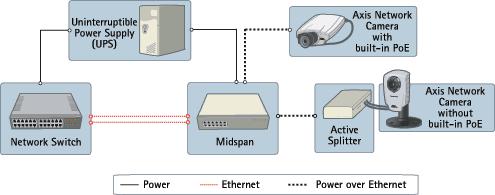| |
|
Power over Ethernet |
| |
|
|
| |
|
Power over Ethernet (PoE) is a technology that integrates power into a standard LAN infrastructure. It enables power to be provided to the network device, such as an IP phone or a network camera, using the same cable as that used for network connection. It eliminates the need for power outlets at the camera locations and enables easier application of uninterruptible power supplies (UPS) to ensure 24 hours a day, 7 days a week operation.
PoE technology is regulated in a standard called IEEE 802.3af and is designed in a way that does not degrade the network data communication performance or decrease the network reach. The power delivered over the LAN infrastructure is automatically activated when a compatible terminal is identified, and blocked to legacy devices that are not compatible. This feature allows users to freely and safely mix legacy and PoE-compatible devices, on their network.
The standard provides power up to 15.4W on the switch or midspan side, which translates to a maximum power consumption of 12.9W on the device/camera side - making it suitable for indoor cameras. Outdoor cameras as well as PTZ and dome cameras have a power consumption that normally exceeds this, making PoE functionality less suitable. Some manufacturers also offer non-standard proprietary products providing suitable power for these applications as well, but it should be noted that since these are non-standard products, no interoperability between different brands is possible. The 802.3af standard also provides support for so-called power classification, which allows for a negotiation of power consumption between the PoE unit and the devices. This means an intelligent switch can reserve sufficient, and not superfluous, power for the device (camera) - with the possible result that the switch could enable more PoE outputs
|
| |
|
|
| |
|
Using Power over Ethernet
|
| |
|
|
| |
|
PoE works across standard network cabling (i.e. cat-5) to supply power directly from the data ports to which networked devices are connected. Today, most manufacturers offer network switches with built-in PoE support. If an existing network /switch structure is in place, customers can benefit from the same functionality by adding a so-called Midspan to the switch, which will add power to the network cable. All network cameras without built-in PoE can be integrated in a PoE system using an Active Splitter.
The following diagram shows how a network camera can receive power over a network cable and can continue to function even when there is a power failure.
|
| |
|
|
| |
|
 |
| |
|
|
| |
|
Midspans & active splitters
|
|
|
|
| |
|
EX4U Telecom provides two types of accessories that enable network video products to
receive power and data over an Ethernet connection:
Midspans
|
A midspan is connected in between the switch/hub and the PoE-enabled products. It uses the unused pairs in a standard Cat 5
network cable to supply power to PoE-enabled devices.
|
Active splitters
|
An active splitter gives the network video
products that lack built-in support for Power over Ethernet, the ability
to receive power over the network by splitting the data and power coming
over the network cable. (With products that have built-in Power over
Ethernet, an active splitter is not required.)
|
|
| |
|
|
| |
|
top
back
|
|
|